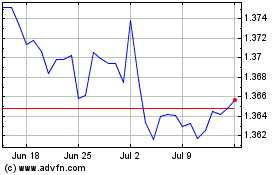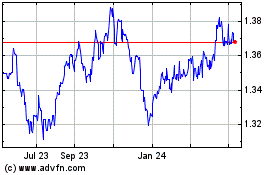Dollar Falls Despite Robust U.S. Jobs Data
March 10 2017 - 4:08AM
RTTF2
The U.S. dollar drifted lower against its major counterparts in
the European session on Friday, despite the release of upbeat jobs
data for February that backed hopes for an increase in interest
rates at next week's Federal Reserve meeting.
Data from the Labor Department showed that non-farm payroll
employment jumped by 235,000 jobs in February after surging up by a
revised 238,000 jobs in January.
Economists had expected employment to climb by about 195,000
jobs compared to the addition of 227,000 jobs originally reported
for the previous month.
With the stronger than expected job growth, the unemployment
rate edged down to 4.7 percent in February from 4.8 percent in
January, matching expectations.
The report also said the annual rate of growth in average hourly
employee earnings accelerated to 2.8 percent in February from 2.5
percent in January.
The US Federal Reserve kicks off a two-day meeting next week
with the decision expected at 2:00 pm ET Wednesday. Economists are
predicting a 0.25 percent boost in benchmark rate to a range of
0.75 percent - 1 percent.
Fed officials, including Chairwoman Janet Yellen, had already
strongly hinted at a March hike in their statements lately, given
solid economic growth.
The greenback showed mixed performance in the Asian session.
While the currency held steady against the pound and the franc, it
dropped against the euro. Against the yen, it rose.
The greenback pared gains to 1.0107 against the Swiss franc,
from a high of 1.0139 hit in the immediate aftermath of the jobs
data. The greenback is likely to target support around the 1.00
zone.
Following near a 2-month high of 115.50 hit at 8:00 am ET, the
greenback retreated to 115.12 against the Japanese yen.
Continuation of the greenback's downtrend may see it challenging
support around the 114.00 region.
Data the Ministry of Finance showed that Japan's large
manufacturing conditions deteriorated in the first quarter of 2017,
with a score of 1.1.
That was down sharply from 7.5 in the previous three months, and
well shy of expectations for 8.4.
Extending early slide, the greenback slipped to a 4-day low of
1.0634 against the euro. The greenback is poised to challenge
support around the 1.08 mark.
Data from Destatis showed that Germany's wholesale prices
increased the most in more than five years in February.
Wholesale prices advanced 5 percent in February from prior year,
following a 4 percent increase in January.
The greenback gave up some of its early gains against the pound
with the pair trading at 1.2170. This may be compared to a high of
1.2136 hit immediately after the release of the data. The next
possible support for the greenback may be located around the 1.235
zone.
Data from the Office for National Statistics showed that the UK
visible trade deficit remained broadly unchanged in January.
The deficit on trade in goods, came in at GBP 10.83 billion
versus GBP 10.91 billion shortfall in December.
The greenback dropped to 2-day lows of 1.3427 against the loonie
and 0.7556 against the aussie, from its previous highs of 1.3515
and 0.7498, respectively. Further weakness may see the greenback
challenging support around 0.77 against the aussie and 1.33 against
the loonie.
Reversing from an Asian session's rise of 0.6891 against the
kiwi, the greenback slipped to a 2-day low of 0.6941. If the
greenback extends decline, 0.70 is possibly seen as its next
support level.
Looking ahead, U.S. Baker Hughes rig count data is set to be
announced in the New York session.
At 2:00 pm ET, U.S. Federal Reserve monthly budget balance
statement is due.
US Dollar vs CAD (FX:USDCAD)
Forex Chart
From Mar 2024 to Apr 2024

US Dollar vs CAD (FX:USDCAD)
Forex Chart
From Apr 2023 to Apr 2024
